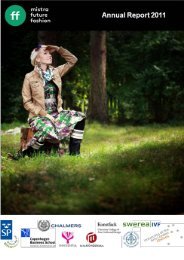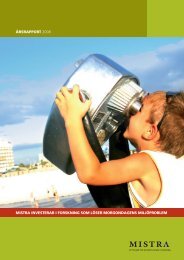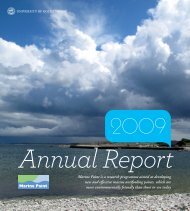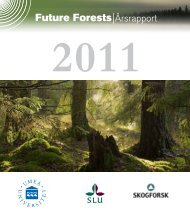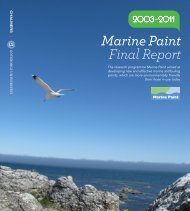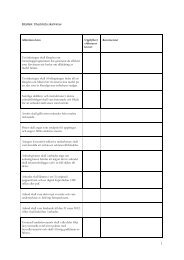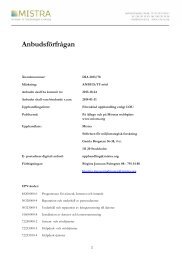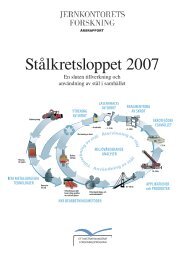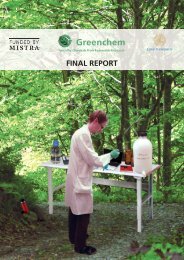analysis is an important next step to make habitat suitability models moreefficient as planning tools in forest management.We examined the spatial functionality of old spruce-dominated forest inseveral regions of Sweden through the perspective of organisms with differentecologies, in terms of their area requirements and mobility (Mikusinski &Edenius 2006), using virtual species representing a gradient of these two ecologicaltraits. <strong>The</strong> main tool was habitat suitability modeling. Countrywideestimates of forest variables derived from satellite data and field data from theNational Forest Inventory using the kNN-method (k-Nearest Neighbor)were used as sources of habitat distribution data. We found large regionalvariations in old spruce forest functionality depending on natural conditionsand forest history. <strong>The</strong> relationship between functionality and amountwas largely curvilinear. Areas with >10% of old spruce forest generally havehigh levels of spatial functionality, whereas high variation in functionalitywas observed in areas with little old spruce forest cover. We found that ourmethod for multiple-scale assessment of old forest functionality may be helpfulin regional forest biodiversity planning.Effective management of biodiversity in production landscapes requires aconservation approach that acknowledges the complexity of ecological andcultural systems in time and space (Mikusinski et al. 2007). This includesextensions of current methods for conservation planning to consider therelative contributions to conservation objectives of different forms of management,the effects of changes in land use, and the requirements for practicalimplementation. As a contribution to meeting the challenge posed byCountdown 2010, we presented an example of a planning exercise that useda spatially explicit conservation planning tool to incorporate the knowledgeof regional experts on biodiversity. We placed this exercise in the context ofthe requirements of Countdown 2010 by presenting a general framework forforest conservation planning.Using an extensive data-set of species occurrences and forest and landscapevariables, we analyzed the habitat-occurrence relationships of nineresident boreal forest bird species in Sweden (Edenius et al. submitted). Wedecomposed the variation at different sampling units and tested the effect ofhabitat on bird occurrence at different spatial scales using generalized mixedeffects models (GLMMs). <strong>The</strong> ability of the habitat variables to explain theoccurrence patterns was highly variable. Large variation at the smallest scalesuggests that further research should be directed towards understanding theimportance of both fine-scale variation in habitat suitability and detectionprobability in order to increase the predictive power of species-habitat models.We have demonstrated the usefulness of our biodiversity assessmentapproach in case studies covering regional conservation planning at countyscale (Örebro) and long-term planning at the forest estate level (Remningstorp,Sundsvall, Krycklan). We have also co-operated within the <strong>Heureka</strong>program, by participating in efforts to find optimal solutions to combine high54
forest net value revenues and the promotion of habitats for selected speciesfor finding optimal solutions. Results from the project have been communicatedin a number of peer-reviewed papers, public reports (Faktablad), seminarswith forest owners, forest managers, forestry authorities and other stakeholders,NGO’s, and over the internet.Fulfillment of objectives<strong>The</strong> biodiversity assessment module has been developed and delivered. Specieshabitat requirements have been translated into forest data such as thevolume (age) of main tree species, i.e. data readily available and frequentlyused in forest management planning. <strong>The</strong>se variables were useful as habitatdescriptors in our habitat models, at least over broader spatial scales. However,a drawback was that we could not predict finer scale distributions ofmodel species. Moreover, due to a lack of reliable data on the amount anddistribution of coarse woody debris, we were forced to limit the number ofspecies dependent on dead wood. This was unfortunate since the majorityof threatened species in the Swedish forests are saproxylic. We thereforehope for better data on this substrate in future. Also, data on individual trees(diameter) would be helpful in developing refined models built on foreststructural characters.ReferencesScientific articlesMikusinski, G. & Edenius, L. 2006. Assessment of spatial functionality of old forest inSweden as habitat for virtual species. Scandinavian Journal of Forest <strong>Research</strong> 21 (Suppl.7): 73-83.Edenius, L. & Mikusinski, G. 2006. Utility of habitat suitability models as biodiversityassessment tools in forest management. Scandinavian Journal of Forest <strong>Research</strong> 21(Suppl. 7): 62-72.Mikusinski, G., Pressey, R. L., Edenius, L., Kujala, H., Moilanen, A., Niemelä, J., &Ranius, T. 2007. Conservation Planning in Forest Landscapes of Fennoscandia, and anApproach to the Challenge of Countdown 2010. Conservation Biology 21: 1445-1454.Edenius, L., Mikusinski, G., et al. Matching national bird breeding surveys with foresthabitat data: influence of spatial and structural components of the data (submitted to Ecography)Öhman, K., Edenius, L., Mikusinski, G. Optimizing spatial habitat suitability and timberrevenue in long-term forest planning: a case study of the habitat demands of HazelGrouse (submitted to Canadian Journal of Forest <strong>Research</strong>)55
- Page 3: ContentsResearch Programme 5Applica
- Page 7 and 8: Growth and yieldmodelsSP1 Forest Ec
- Page 9 and 10: forest production, and social value
- Page 11 and 12: Applications of the Heureka systemT
- Page 13 and 14: data, improving opportunities to in
- Page 15 and 16: User valueA complete decision suppo
- Page 17 and 18: opment scenarios for a stand that w
- Page 19 and 20: Programme meeting including an excu
- Page 21 and 22: forest roads, 10 time periods, four
- Page 23 and 24: Figure 6. Examples of screen layout
- Page 25 and 26: Implementations in practical forest
- Page 27 and 28: Thematic research projectsGrowth an
- Page 29 and 30: 600PineSpruceBirch500400Max-age, yr
- Page 31 and 32: Specification of silviculturaland n
- Page 33 and 34: zones and other tree groups. Border
- Page 35 and 36: expresses the expected potential in
- Page 37 and 38: tions, mainly using current forest
- Page 39 and 40: ReferencesPopular science publicati
- Page 41 and 42: identified relationships were used
- Page 43 and 44: Fulfilment of objectivesThe goal of
- Page 45 and 46: Soil biogeochemical modellingProjec
- Page 47 and 48: Scientific resultsSoil carbon model
- Page 49 and 50: model (Fig. 18). In addition, the w
- Page 51 and 52: Hodson, M.E., Langan, S.J. & Wilson
- Page 53: phytes, fungi, lichens, invertebrat
- Page 57 and 58: Wood propertiesProject leader: Lars
- Page 59 and 60: pulpwood energy wood sections) are
- Page 61 and 62: Table 1. Properties that can be pre
- Page 63 and 64: Hannrup, B. et al. (manuscript). Mo
- Page 65 and 66: value model, based on both stand at
- Page 67 and 68: uscript in prep.Working papersLindh
- Page 69 and 70: een tested.Estimates of forest para
- Page 71 and 72: Conference proceedingsNilsson, M.,
- Page 73 and 74: Selection of plot data to represent
- Page 75 and 76: set, in the BIOMASS and IRIS projec
- Page 77 and 78: the end of the project period. The
- Page 79 and 80: y a study of the consequences for H
- Page 81 and 82: Field trials in the project Data ac
- Page 83 and 84: Fulfillment of objectivesThe main e
- Page 85 and 86: vests? As a result, for the identif
- Page 87 and 88: Figure 26. The spatial layout of ha
- Page 89 and 90: Multi-Criteria Decision AnalysisPro
- Page 91 and 92: !"#$%&'N)';%&4&32-2",3',6'5-2-'6,%'
- Page 93 and 94: problems. Spatial problems pose par
- Page 95 and 96: Forest owner behaviour and dynamics
- Page 97 and 98: area between these size groups has
- Page 99 and 100: Programme managementWhen the second
- Page 101 and 102: Funding and expenditureFundingThe s
- Page 103 and 104: Publications in phase I and phase I
- Page 105 and 106:
Freeman, M., Severinsson, T., Moré
- Page 107 and 108:
Pettersson, H. & Ståhl, G. 2006. F
- Page 109 and 110:
forests at the landscape level. MSc
- Page 111 and 112:
Lanvin, J-D. Bajric, F. Wilhelmsson
- Page 113 and 114:
ceedings from the 24th EARSeL Sympo
- Page 115 and 116:
ceedings 3rd Forest Engineering Con
- Page 117 and 118:
Lämås, T., Ståhl, G. och Dahlin,
- Page 119:
Anon., 2005. The Heureka Research P



